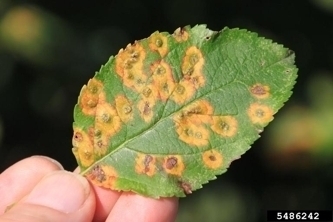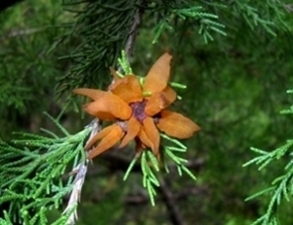Apples and flowering crabapples are susceptible to several rust diseases including cedar-apple rust, quince rust, and hawthorn rust. Although incited by different species of fungi in the genus Gymnosporangium, they have in common the fact that they must spend part of their life cycle on various trees and shrubs of the Juniperus species such as Eastern red cedar and common juniper. Any of the rust diseases can result in serious losses if environmental conditions are favorable for disease development. Since they are similar in appearance and life cycles, only cedar-apple rust will be discussed in detail.
Symptoms

Symptoms of cedar-apple rust are found on apples and Juniper spp. On apples, rust occurs on leaves and fruit and less commonly on bark tissue. Small yellow spots appear on the upper leaf surface usually within a week or two after flower bloom. The spots enlarge to ¼” or more and orange droplets appear in the center. Eventually the fungus produces small black fruiting bodies in the in those spots. Later in the summer another type of fruiting structure containing spores of the fungus is produced on the underside of the leaf. These fruiting structures appear as a series of yellowish tubes called aecia. Some infected leaves may drop from the tree but complete defoliation rarely occurs.
Fruit infection spots usually occur near the calyx end, are similar in color to the leaf infection spots, but may become much larger- ½” or more in diameter. Black fruiting bodies and, occasionally, aecia, develop on the fruit lesion.

On the small branches of Juniperus spp. the fungus causes brown to reddish-brown swellings or galls ¼” to 2” in diameter. These galls, commonly called cedar apples, take two years to mature. During rainy periods in May orange gelatinous tendrils or spore horns develop on the galls. These may extend from the gall as much as 2”. Each gall may have more than one hundred spore horns. During dry periods in May and June the spore horns lose their gelatinous consistency and appear inactive. However, they regain their appearance and function with the return of wet conditions. Sometime in late June the spore horns dry up and fall off. The gall persists on the tree but does not function again. Severely infected trees may contain hundreds of individual galls.
Disease Cycle

Spores are produced on spore horns on Juniperus spp. In the spring they are very lightweight and are easily carried by the wind to apple leaves and fruit. Billions of spores can be produced on a single spore horn. Release of spores occurs during rainy periods. In Connecticut, spores are released until about the middle of June.
If a spore lands on a susceptible apple leaf and environmental conditions are favorable infection can occur in as little as four hours. In one-three weeks rust lesions appear on the apple leaves. Spores produced in aecia on apple leaves are wind disseminated back to the leaves of Juniperus spp. The spores germinate, penetrate the leaves and cause the galls to form. The galls produce spores the second spring after infection occurs completing the two-year life cycle of the fungus.
Control
Removal of Juniperus spp. from the vicinity of apple orchards has been suggested as a means of control. However, since spores produced on cedar can be wind disseminated several miles, tree removal cannot be expected to give complete control. However, removing Juniperus spp. in the immediate vicinity of orchards can reduce the severity of the disease.
On Juniperus spp. chemical control of rust is seldom necessary. Hand-picking of the galls before the spore horns emerge is a common practice. Juniperus spp. infected with cedar-apple rust will not die from the disease.
Fungicide control should be sprayed at bud break and then weekly until petal fall. Use a fungicide that contains copper, sulfur or mancozeb as an active ingredient. Apple varieties differ greatly in their resistance to rust. Following is a list of varieties of apples grown in the test block at the University of Connecticut Experimental Orchard located in Storrs, CT. It includes their relative resistance to rust.
Resistant or Immune Apple Varieties
- Carroll
- Delicious
- Empire
- Holly
- Honeygold
- Jonamac
- Jersey Mac
- Lobo
- Mollies Delicious
- Macoun
- McIntosh
- Niagra
- Priscilla
- Paulared
- Raritan
- Spencer
- Scotia
- Stayman
- Sungold
- Shenandoah
Apple Varieties with Intermediate Resistance
- Barry
- Earliblaze
- Golden Delicious
- Magnolia Gold
- Razor Russet
- Spigold
- Stark's Bounty
- Winesap
Susceptible Apple Varieties
- Burgundy
- Esopus Spitzenburg
- English Russet
- Gala
- Honeycrisp
- Idared
- Jonee
- Jono
- July Red
- Jonagold
- Lura Red
- Monroe
- Ozark Gold
- Prima
- Quinte
- Rome
- Roanoke
- Red Baron
- Roxbury Russet
- Summerred
- Stark Jumbo
- Vista Bella
Resistant Crab Apple Varieties
- Malus cv ‘Adams’
- M. floribunda
- M. hypehensis
- M. cv ‘Mary Potter’
- M. sargentii
- M. cv ‘Snowdrift’
- M/ cv ‘Winter Gold’
Native flowering crabapples such as wild sweet crab, Malus coronaria, and prairie crab, M. ioensis and its cultivars, fringe petal crab, M. ioensis ‘Fimbriata’ and bechtal crab, M. ioensis ‘Plena’, should be avoided if rust is serious in a particular location.
Resistant Hawthorn Varieties
- Cockspur hawthorn
- Washington hawthorn
Despite good cultural practices, pests and diseases at times may appear. Chemical control should be used only after all other methods have failed. For pesticide information please call UConn Home and Garden Education Center or your local cooperative extension office.
The UConn Home & Garden Education Center supports UConn Extension’s mission by providing answers you can trust with research-based information and resources. For gardening questions, contact us toll-free at (877) 486-6271, visit our website at homegarden.cahnr.uconn.edu, or reach out to your local UConn Extension center at cahnr.uconn.edu/extension/locations.
Revised by the UConn Home & Garden Education Center, 2019.